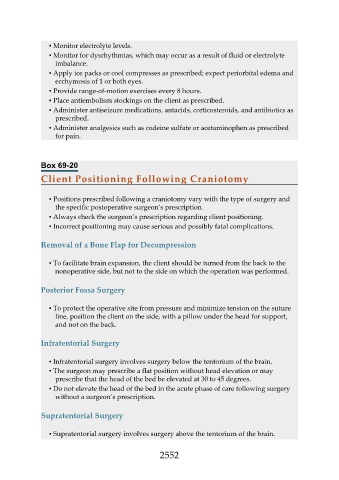Page 2552 - Saunders Comprehensive Review For NCLEX-RN
P. 2552
▪ Monitor electrolyte levels.
▪ Monitor for dysrhythmias, which may occur as a result of fluid or electrolyte
imbalance.
▪ Apply ice packs or cool compresses as prescribed; expect periorbital edema and
ecchymosis of 1 or both eyes.
▪ Provide range-of-motion exercises every 8 hours.
▪ Place antiembolism stockings on the client as prescribed.
▪ Administer antiseizure medications, antacids, corticosteroids, and antibiotics as
prescribed.
▪ Administer analgesics such as codeine sulfate or acetaminophen as prescribed
for pain.
Box 69-20
Client Positioning Following Craniotomy
▪ Positions prescribed following a craniotomy vary with the type of surgery and
the specific postoperative surgeon’s prescription.
▪ Always check the surgeon’s prescription regarding client positioning.
▪ Incorrect positioning may cause serious and possibly fatal complications.
Removal of a Bone Flap for Decompression
▪ To facilitate brain expansion, the client should be turned from the back to the
nonoperative side, but not to the side on which the operation was performed.
Posterior Fossa Surgery
▪ To protect the operative site from pressure and minimize tension on the suture
line, position the client on the side, with a pillow under the head for support,
and not on the back.
Infratentorial Surgery
▪ Infratentorial surgery involves surgery below the tentorium of the brain.
▪ The surgeon may prescribe a flat position without head elevation or may
prescribe that the head of the bed be elevated at 30 to 45 degrees.
▪ Do not elevate the head of the bed in the acute phase of care following surgery
without a surgeon’s prescription.
Supratentorial Surgery
▪ Supratentorial surgery involves surgery above the tentorium of the brain.
2552

